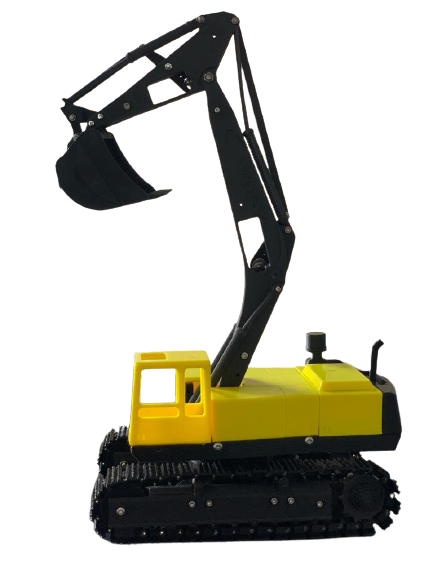 |
EDUCATIONAL PROGRAMME 3D – MODELLING
3D modeling is the process of creating a three-dimensional model of an object. 3D modeling is considered to be automated methods of making objects based on given parameters. This is the technology by which lasers and other special devices apply the material layer by layer, recreating the computer-generated 3D model.
Part number:
Price: 5 000 RUR
Supplier:
Progression LLCDescription
Explanatory note
The program of supplementary education of children and adults «3D - modeling» has been drafted according to the requirements of the following statutory documents:
Federal Law of 29.12.2012.273-FZ «On Education in the Russian Federation»
The Plan for the Development of Supplementary Education for Children (approved by Government Order of 04.09.2014 1726-r)
Order of the Ministry of Education of Russia from 09.11.2018.196 «On approval of the Procedure for organization and implementation of educational activities on supplementary general education programs»
Letter from the Ministry of Education and Science of the Russian Federation dated 11.12.2006 06-1844 «On Indicative Requirements for Supplementary Education Programs for Children»
Letter of the Ministry of Education and Science of the Russian Federation 09 - 3242 dated 18.11.2015 «On the Sending of Information»
The programme has a technical focus.
Topicality
3D modeling is the process of creating a three-dimensional model of an object. 3D modeling is considered to be automated methods of making objects based on given parameters. This is the technology by which lasers and other special devices apply the material layer by layer, recreating the computer-generated 3D model.
With 3D printing it is possible to create details of any complexity and configuration, while at the same time reducing the amount of waste produced. 3D printing technologies are applicable to almost any material: metals, alloys, polymers, etc.
Applications of 3D modelling:
Aerospace industry
Medicine and dentistry;
Engineering and engine building;
Pharmacology
Construction
advertising
Garment making
commercial and management activities.
3D modeling is based on the application of computer technologies that are subject to rapid change, e.g. graphics systems that allow to build models of any complexity. 3D modeling software is designed for users with different levels of training, from professionals in the industry to school-age children. The value of teaching 3D printing to schoolchildren is due to the widespread use of these technologies and the growing demand for them, so 3D printing may become a part of the school curriculum in the near future.
Originality
The originality of the programme is that it involves the integration of knowledge and skills that are the core of engineering literacy:
working with modern 3D design systems;
fast prototyping technologies, including 3D printing;
creation of three-dimensional models of different complexity;
software modeling for 3D modeling.
The pedagogical practicability of the supplementary educational programme "3D-modelling" is due to the wide possibilities of using the acquired knowledge and skills in various fields of modern activity. The programme opens the way to creativity, develops technical thinking and provides new opportunities.
The aim of the training is to acquire 3D modeling skills using modern software and equipment (3D printers).
Tasks:
familiarize yourself with the fundamentals of 3D modelling;
to be able to represent the shape of the objects to be designed;
acquire software simulation skills for 3D modeling (Autodesk TinkerCad);
basic 3D printing skills: modify, modify and edit objects or their individual elements; create 3D models of different complexity and print them on a 3D printer;
develop spatial imagination, technical and project thinking;
develop the cognitive and creative capacities of learners;
develop a sustained interest in search and creative activities.
Age of learners: 10 years and older.
Programme duration: 16 hours.
9 academic hours - lectures and presentations;
3 hours - self-study of Autodesk TinkerCad software;
2 hours - independent modelling of 3D models;
1 hour - exam in the form of testing.
Planned results
As a result of the programme, students will:
Know:
3D modeling terms
basic 3D modeling;
methods and techniques for model editing;
3D modeling software (Autodesk TinkerCad).
Be able to:
create and edit 3D models;
correct the defects detected during the printing process of 3D models and minor defects of the 3D printer;
prepare models for printing.
Forms of monitoring and evaluation
The final form of control at the end of each section of the program is the examination.
TRAINING PLAN
№ Theme
Desktop holder in Tinkercad: Introduction to Tinkercad
Desktop holder in Tinkercad: Step 1-4: Creating a base of the model and the pen holder
Desktop holder in Tinkercad: Step 5-6: Creating a phone/name card holder
Desktop holder in Tinkercad: Step 7-8: Creating a shelf/drawer
Walking ladybug in Tinkercad: Introductory and first two steps
Walking ladybug in Tinkercad: Step 3 and 4#1 - creating legs and the frame
Walking ladybug in Tinkercad: Step 4#2 – creating the frame of the ladybug
Walking ladybug in Tinkercad: Step 5 – creating the crank
Walking ladybug in Tinkercad: Step 6 and 7– creating the gears
Walking ladybug in Tinkercad: Step 8 and 9 – creating the battery and switch holders
Walking ladybug in Tinkercad: Step 10#1 – creating the bracket
Walking ladybug in Tinkercad: Step 10#2 – continuing creating the bracket
Walking ladybug in Tinkercad: Step 11 – creating the head
Walking ladybug in Tinkercad: Step 12#1 – creating the body
Walking ladybug in Tinkercad: Step 12#2 – continuing creating the body
Walking ladybug in Tinkercad: Step 12#3 – the final stages
Walking ladybug in Tinkercad: Introductory and first two steps
Self-study of Autodesk TinkerCad software
Independent modelling of 3D models
Exam (test)
Organizational and pedagogical conditions for the implementation of the programme.
Training and methodological support for the programme
Classes are held in the form of video lectures and presentations.
Method of self-study. Freedom of choice of subject, methods and mode of work, creation of conditions for creativity.
Method of visual impact. Visual demonstration of drawings, printed models.
Logistics of the programme
The training process requires:
network equipment
internet access
personal computer (Mac, Windows)
software (Autodesk TinkerCad)
The program of supplementary education of children and adults «3D - modeling» has been drafted according to the requirements of the following statutory documents:
Federal Law of 29.12.2012.273-FZ «On Education in the Russian Federation»
The Plan for the Development of Supplementary Education for Children (approved by Government Order of 04.09.2014 1726-r)
Order of the Ministry of Education of Russia from 09.11.2018.196 «On approval of the Procedure for organization and implementation of educational activities on supplementary general education programs»
Letter from the Ministry of Education and Science of the Russian Federation dated 11.12.2006 06-1844 «On Indicative Requirements for Supplementary Education Programs for Children»
Letter of the Ministry of Education and Science of the Russian Federation 09 - 3242 dated 18.11.2015 «On the Sending of Information»
The programme has a technical focus.
Topicality
3D modeling is the process of creating a three-dimensional model of an object. 3D modeling is considered to be automated methods of making objects based on given parameters. This is the technology by which lasers and other special devices apply the material layer by layer, recreating the computer-generated 3D model.
With 3D printing it is possible to create details of any complexity and configuration, while at the same time reducing the amount of waste produced. 3D printing technologies are applicable to almost any material: metals, alloys, polymers, etc.
Applications of 3D modelling:
Aerospace industry
Medicine and dentistry;
Engineering and engine building;
Pharmacology
Construction
advertising
Garment making
commercial and management activities.
3D modeling is based on the application of computer technologies that are subject to rapid change, e.g. graphics systems that allow to build models of any complexity. 3D modeling software is designed for users with different levels of training, from professionals in the industry to school-age children. The value of teaching 3D printing to schoolchildren is due to the widespread use of these technologies and the growing demand for them, so 3D printing may become a part of the school curriculum in the near future.
Originality
The originality of the programme is that it involves the integration of knowledge and skills that are the core of engineering literacy:
working with modern 3D design systems;
fast prototyping technologies, including 3D printing;
creation of three-dimensional models of different complexity;
software modeling for 3D modeling.
The pedagogical practicability of the supplementary educational programme "3D-modelling" is due to the wide possibilities of using the acquired knowledge and skills in various fields of modern activity. The programme opens the way to creativity, develops technical thinking and provides new opportunities.
The aim of the training is to acquire 3D modeling skills using modern software and equipment (3D printers).
Tasks:
familiarize yourself with the fundamentals of 3D modelling;
to be able to represent the shape of the objects to be designed;
acquire software simulation skills for 3D modeling (Autodesk TinkerCad);
basic 3D printing skills: modify, modify and edit objects or their individual elements; create 3D models of different complexity and print them on a 3D printer;
develop spatial imagination, technical and project thinking;
develop the cognitive and creative capacities of learners;
develop a sustained interest in search and creative activities.
Age of learners: 10 years and older.
Programme duration: 16 hours.
9 academic hours - lectures and presentations;
3 hours - self-study of Autodesk TinkerCad software;
2 hours - independent modelling of 3D models;
1 hour - exam in the form of testing.
Planned results
As a result of the programme, students will:
Know:
3D modeling terms
basic 3D modeling;
methods and techniques for model editing;
3D modeling software (Autodesk TinkerCad).
Be able to:
create and edit 3D models;
correct the defects detected during the printing process of 3D models and minor defects of the 3D printer;
prepare models for printing.
Forms of monitoring and evaluation
The final form of control at the end of each section of the program is the examination.
TRAINING PLAN
№ Theme
Desktop holder in Tinkercad: Introduction to Tinkercad
Desktop holder in Tinkercad: Step 1-4: Creating a base of the model and the pen holder
Desktop holder in Tinkercad: Step 5-6: Creating a phone/name card holder
Desktop holder in Tinkercad: Step 7-8: Creating a shelf/drawer
Walking ladybug in Tinkercad: Introductory and first two steps
Walking ladybug in Tinkercad: Step 3 and 4#1 - creating legs and the frame
Walking ladybug in Tinkercad: Step 4#2 – creating the frame of the ladybug
Walking ladybug in Tinkercad: Step 5 – creating the crank
Walking ladybug in Tinkercad: Step 6 and 7– creating the gears
Walking ladybug in Tinkercad: Step 8 and 9 – creating the battery and switch holders
Walking ladybug in Tinkercad: Step 10#1 – creating the bracket
Walking ladybug in Tinkercad: Step 10#2 – continuing creating the bracket
Walking ladybug in Tinkercad: Step 11 – creating the head
Walking ladybug in Tinkercad: Step 12#1 – creating the body
Walking ladybug in Tinkercad: Step 12#2 – continuing creating the body
Walking ladybug in Tinkercad: Step 12#3 – the final stages
Walking ladybug in Tinkercad: Introductory and first two steps
Self-study of Autodesk TinkerCad software
Independent modelling of 3D models
Exam (test)
Organizational and pedagogical conditions for the implementation of the programme.
Training and methodological support for the programme
Classes are held in the form of video lectures and presentations.
Method of self-study. Freedom of choice of subject, methods and mode of work, creation of conditions for creativity.
Method of visual impact. Visual demonstration of drawings, printed models.
Logistics of the programme
The training process requires:
network equipment
internet access
personal computer (Mac, Windows)
software (Autodesk TinkerCad)

